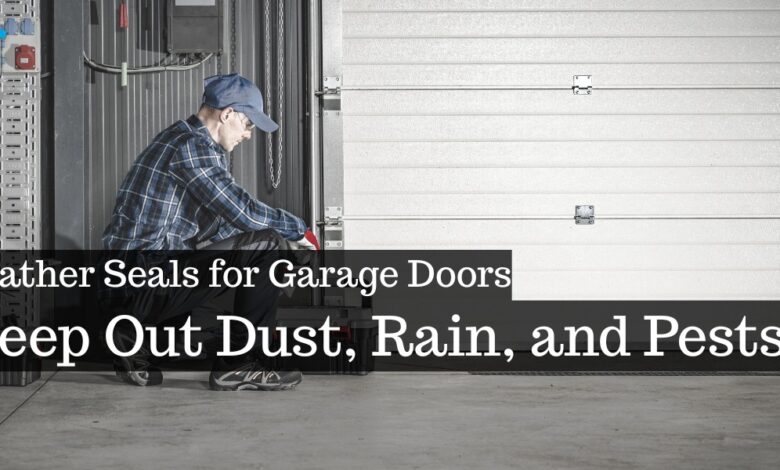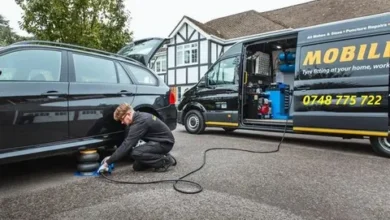Weather Seals for Garage Doors: Keep Out Dust, Rain, and Pests

After last month’s storm, Sarah from Kenmore noticed something odd. A fine layer of red dust covered every tool in her garage, and small puddles formed near the door even though her roof wasn’t leaking. When she spotted droppings in the corner, she realised her garage door seals had completely failed.
She’s not alone in missing these warning signs. Worn weather seals cause issues that most people don’t immediately link to their garage door. Here’s what we’ll walk through today:
- Different seal types and what each one does
- Warning signs that mean your seals need attention
- How proper sealing saves you money over time
- Simple maintenance habits that extend seal life
These insights will help you protect your belongings and avoid costly repairs down the track.
If you want to keep your garage sealed and protected from Brisbane’s weather, keep reading with DoorsDirect.
What Weather Seals Actually Do for Your Garage Door
Think of it this way: your garage door seals work like weatherstripping on your front door, just on a much larger scale. They create protective barriers between the door edges and the frame, blocking out everything you don’t want inside.

These seals stop moisture during Brisbane’s heavy downpours and keep dust out year-round. During summer storms, a tight seal prevents that fine red dust from coating your tools and stored items. Without proper seals, you’re basically leaving small gaps open to the weather all day, every day.
The seals also block entry points where pests typically squeeze through. Mice can fit through openings as small as six millimetres, and insects need even less space. A single gap at the bottom of your garage door becomes a welcome mat for rodents looking for shelter.
When seals fail, rain doesn’t just create puddles on your garage floor. The moisture seeps into corners, where it causes rust on metal items and encourages mould growth. Good door seals keep these elements outside where they belong.
Different Types of Door Seals You Should Know About
Your garage door relies on three main seal types, and each one protects a different area. Bottom seals handle ground contact, side seals run along the tracks, and threshold seals attach to your floor.

We recommend getting familiar with each type because it makes spotting wear and ordering replacements much easier when issues come up.
Bottom Seals
Bottom seals attach to your door’s lower edge and press against the floor when closed. Since 2008, we’ve replaced hundreds of these across Brisbane, and we’ve noticed they wear out faster than any other seal type.
They take the hardest beating from constant ground friction and exposure to driveway debris. Every time your door opens and closes, the bottom seal drags across concrete or gets hit by small rocks.
Heavy-duty rubber versions last much longer in garages that get used multiple times daily. These thicker seals handle Brisbane’s conditions better and won’t crack as quickly under our summer heat.
Side and Top Seals
These seals run along the vertical tracks and across the top header to close off frame gaps. Most people never notice them until they fail, but they stop wind-driven rain from seeping into your garage.
Side seals do double duty by reducing noise when your door operates. They cushion the metal-to-metal contact as panels slide along the tracks, which means less rattling and scraping sounds.
About top seals: they get overlooked during most inspections, even though they block just as much dust and smoke as the side ones.
Threshold Seals
Threshold seals get fitted to your garage floor instead of the door itself. They work well for uneven concrete slabs common in older Brisbane suburbs like Ashgrove and Paddington.
These floor-mounted seals fill the gaps that bottom door seals can’t quite reach on sloping driveways. The seal creates a small ramp that the door presses down onto, forming a tight barrier.
Timber garages sometimes need threshold seals because the door sits higher off the ground than modern steel doors do.
Now that you know which seals protect your garage, let’s look at how they actually save you money.
How Weather Seals Save You Money
Quality weather seals pay for themselves through savings you’ll see every month. Most homeowners don’t realise worn seals drain their wallets through costs that add up quietly over time.
Good news: quality seals don’t cost an arm and a leg, and within months, you’ll notice the difference in several areas.
- Reduced pest control expenses. Sealed garages block the entry points that rodents and insects use to get inside. Once pests establish themselves in your garage, you’re looking at regular pest control visits and potential damage to stored items that costs far more than new seals.
- Lower cleaning costs. Less dust means you spend less time and money keeping your garage space usable (and yes, we’ve all swept out that same red dust three times in one week). Your car stays cleaner when parked inside, and you won’t need to constantly wipe down tools and equipment.
- Decreased energy bills. If you use your garage as a workshop or storage space for temperature-sensitive items, proper air sealing keeps conditioned air from escaping. This makes a real difference during Brisbane’s hot summers when even a few degrees can turn your workspace from comfortable to unbearable.
- Extended motor life. Doors with secure seals run smoother because they’re not fighting against wind pressure or debris stuck in the tracks. The motor doesn’t strain as much during operation, which means fewer repairs and a longer lifespan for your opener system.
We’ve seen these savings add up to hundreds of dollars yearly for our customers. The money you save on cleaning, pest control, and energy costs usually covers the seal replacement within the first year.
When to Replace Your Garage Door Seals
You know that feeling when something seems a bit off, but you can’t figure out what? Maybe you’ve spotted water marks on your garage floor after Brisbane’s recent storms, or you’re sweeping way more than you used to.
Your seals actually tell you when they’re failing. Catching these signs early, checking here and there around your door frame, stops bigger problems from starting.
To spot them, look for these warning signs around your garage door:
| Sign | What It Means | Urgency |
| Visible cracks or splits | Rubber has broken down from the sun | Replace within weeks |
| Watermarks on the floor | Bottom seal doesn’t touch ground anymore | Replace soon |
| Pest droppings inside | Gaps let pests in | Replace right away |
| Light visible under door | Seal is squashed or damaged | Replace within a month |
| More road noise than usual | Side seals are worn or missing | Replace when you can |
Not all these signs need the same quick action. Pest entry and water damage are your biggest worries (trust us, one possum in your garage tools will convince you real quick). These problems get worse fast and cost you more if you wait. Water that gets through bad seals doesn’t just make puddles, it rusts your metal stuff and grows mould in corners.
Light gaps and extra noise aren’t as urgent. You’ve got more time to plan the replacement since your garage door still works fine. Just get new seals fitted before the next storm season starts, because wind-driven rain finds every weak spot once our summer weather rolls in.
Quick Maintenance Tips to Extend Seal Life
Now that you know when to replace seals, let’s talk about making them last longer. A bit of prevention beats biting the bullet on a full replacement job later.
Clean your seals every three months or so with mild soap and water to get rid of built-up dirt and grime. This simple step keeps the rubber flexible and stops it from drying out too fast. After cleaning, wipe them down with a dry cloth so moisture doesn’t sit in the grooves.
Quick cleaning steps:
- Soap and water every three months
- Remove all dirt from grooves
- Wipe completely dry after cleaning
Check your bottom seals after heavy storms, which hit Brisbane pretty hard during summer months. We’ve seen plenty of seals get damaged by debris washed into driveways during flash flooding. Catching small tears early means you can replace just that section instead of the whole seal.
After storm checks:
- Inspect for debris damage immediately
- Look for tears in the rubber
- Replace damaged sections fast
Use silicone lubricant on your seals twice a year to keep the rubber from cracking. Heavy-duty seals need this treatment too, even though they’re built tougher. The lubricant also helps your door glide smoothly when opening and closing, which saves wear on the motor over time.
Lubrication schedule:
- Apply silicone spray twice yearly
- Cover all seal surfaces evenly
- Helps the door operate more smoothly
Pay attention when your garage door starts sounding different or moving less smoothly. These changes often mean your seals have shifted out of alignment and need adjusting. Fix individual damaged sections right away rather than waiting for the whole seal to fail.
Warning signs to watch:
- New scraping or grinding sounds
- The door is moving differently from usual
- Visible gaps appearing in seals
Professional Weather Seal Services in Brisbane
Sometimes you just need the right tools and know-how to get the job done properly. Some seal replacements need professional help beyond basic DIY garage maintenance, especially when you’re dealing with custom door sizes or damaged frames.
Professional installation makes sure seals fit correctly and give you lasting protection. We stock quality seals suited to Australia’s climate and can get them fitted quickly, usually within a few days of your call. Our service includes checking your garage door alignment, too, because misaligned doors wear out even heavy-duty seals faster than they should.
At Doors Direct, we handle all major brands and can source the right seals for roller doors, sectional doors, and tilt doors. We’re a family-owned business based in Geebung, and we’ve helped hundreds of Brisbane homeowners sort out their seal problems.
Completing the installation properly the first time saves you hassle down the track. Contact our team for garage door weather seal Brisbane services, and we’ll work out which seals suit your door best.
FAQs
How long do weather seals last?
Most quality seals last 5-8 years with proper maintenance in Brisbane conditions. Heavy-duty versions can push past 10 years if you clean and lubricate them regularly.
Can I install them myself?
Bottom seals are DIY-friendly for most people. Side and top seals often need professional fitting because they require precise alignment along the door tracks.
Do all garage doors use the same seals?
No, seal types vary by door style. Roller doors need different profiles than sectional doors, and a single custom door might need specially fitted seals to work properly.



